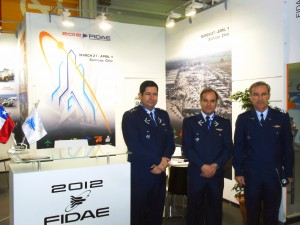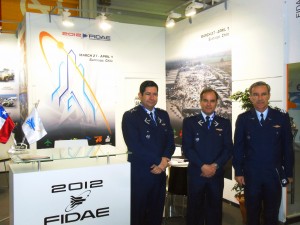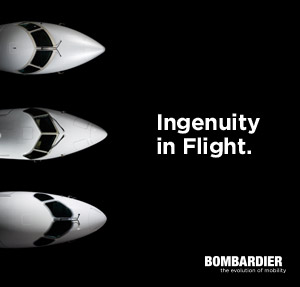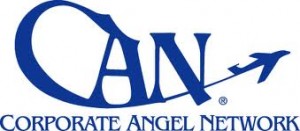Transporte aéreo impulsiona o desenvolvimento econômico da América Latina
July 26, 2011
RIO DE JANEIRO, 26 de julho de 2011 /PRNewswire/ — Líderes da indústria aérea latino-americana irão se encontrar no Brasil para um workshop sobre aviação sustentável. No evento, que reunirá especialistas de aeroportos, companhias aéreas, controladores de tráfego aéreo, fabricantes de aeronaves e motores e autoridades governamentais, serão examinados os desafios decorrentes do crescimento da aviação por toda a América Latina e a forma como a indústria da aviação e os governos poderão trabalhar juntos para vencê-los.
Paul Steele, diretor executivo do ATAG (Air Transport Action Group), grupo que reúne uma coalizão de organizações e empresas da indústria aérea, diz: “Todas as previsões indicam que o número de passageiros na América Latina está aumentando com maior rapidez do que a média mundial. É possível que até 2030 tenhamos 600 milhões de passageiros na região. A questão é: como nos beneficiarmos desse crescimento e, ao mesmo tempo, assegurarmos que venceremos os desafios da sustentabilidade no que diz respeito à infraestrutura, meio ambiente, impactos sociais e benefícios econômicos?”
As companhias aéreas sediadas na América Latina transportam mais de 154 milhões de passageiros a cada ano. A aviação é responsável por 2,4 milhões de empregos que geram quase três vezes mais valor do que outros empregos na economia. Só no Brasil há bem mais do que um milhão de indivíduos empregados no setor aéreo, além de 254.000 pessoas empregadas nas áreas de turismo possibilitadas pela aviação.
“Não há dúvida de que o transporte aéreo tem um papel fundamental no desenvolvimento econômico de todos os países, mas especialmente em economias emergentes de rápido crescimento como o Brasil. A aviação provê conexões dentro do país e entre o Brasil e seus parceiros comerciais na região e internacionalmente. É muito importante que o setor de transporte aéreo seja incentivado pelos governos a crescer de modo responsável, para que seus benefícios se estendam a um número maior de pessoas”, continua Steele.
Estima-se que as atividades da aviação e aeroportos contribuam com quase R$30 bilhões ao ano para a economia brasileira. Esse número não inclui operações industriais, como as da Embraer que contribuem significantemente com a economia brasileira, ou turismo. Essas pessoas têm empregos que requerem um elevado nível de especialização e que pagam bons salários, o que representa uma contribuição ainda maior para as comunidades em que elas vivem e trabalham.”
“O setor aéreo na América Latina está crescendo com maior rapidez do que a média mundial, e esse potencial de crescimento ainda não se esgotou. O Brasil, por exemplo, possui um significativo potencial ainda não explorado. O cidadão americano médio viaja de avião 1,8 vezes ao ano, enquanto o brasileiro médio pega 0,3 voos. À medida que a economia brasileira for se fortalecendo, e a população atingindo a marca de 190 milhões de pessoas, haverá amplas possibilidades para a indústria da aviação crescer e para que áreas como o comércio e o turismo se beneficiem dos efeitos econômicos positivos disso” acrescentou Steele.
O workshop, organizado pelo ATAG, ocorrerá um ano antes da Conferência das Nações Unidas sobre Desenvolvimento Sustentável (também conhecida como Rio+20) no Rio de Janeiro, cujo anfitrião será o governo brasileiro e que terá como foco o desenvolvimento de uma economia verde no contexto do desenvolvimento sustentável.
“A aviação tem um ótimo histórico com relação a isso. Nossos serviços geram empregos e oferecem apoio ao comércio e ao turismo no mundo inteiro. Somos também a única indústria no mundo a ter um conjunto de metas para reduzir nosso impacto nas mudanças climáticas. Limitaremos nossas emissões de dióxido de carbono a partir de 2020 e as reduziremos em 50% até 2050, em comparação a 2005. Nenhuma outra indústria jamais apresentou metas tão ambiciosas” completa Paul Steele.
Material aéreo de Colombia
July 26, 2011
Colombia anunció recientemente, la adquisición de distintas partidas de aeronaves con la finalidad de optimizar su Fuerza Aérea, como asimismo, el repotenciamiento o upgrade de parte de su material aéreo de combate.
Lo anterior, implica la adquisición de 14 Kfir C-10, 4 CASA C-295, 1 Boeing KC-767 de reabastecimiento y 12 KC-390 Embraer. La modernización de material recaerá sobe los Kfir versión C7, los que debieran quedar en su totalidad a estandar C-10.
Hawker Beechcraft Global Customer Support Offers Automatic Climate Control for Fielded Beechcraft Bonanza Aircraft
July 25, 2011
Introductory pricing available during EAA AirVenture 2011
OSHKOSH, Wis. (July 25, 2011) – Hawker Beechcraft Global Customer Support (GCS) today announced it has partnered with KPAK and AC Systems to offer its automatic cabin climate control system for the Beechcraft Bonanza. GCS will offer the product, CabinComfortPlus®, as an aftermarket installation at its factory-owned Hawker Beechcraft Services locations. Customers who order the system during the 2011 EAA AirVenture June 25-31, in Oshkosh, Wis., will receive introductory pricing.
“Adding more cabin comfort is just another way we can create an exceptional customer experience for the Bonanza,” said Christi Tannahill, Hawker Beechcraft vice president, GCS. “CabinComfortPlus brings automotive-style cabin climate control to our piston product line.”
CabinComfortPlus is a fully-automatic cabin climate control system that replaces the current Bonanza cooling system and provides a control panel to set cabin temperature zonally. The operator and/or passengers set the temperature for their zone to the desired setting and the system automatically maintains that temperature, enabling set-and-forget comfort throughout the cabin. The system is also certified for all phases of flight including takeoff and landing without the need to be turned off during startup or shutdown.
More than 40 pounds lighter than the current factory air conditioning system, CabinComfortPlus does not require ducts or scoops in the airflow therefore providing conditioned air without loss of speed due to drag. The system automatically switches between heating and cooling to maintain the desired set temperature lowering pilot workload and increasing safety. All fittings and hoses meet the Montreal Protocol for automobile air conditioning system integrity, providing no loss of refrigerant over time for improved reliability. During low aircraft voltage or engine starting, the system automatically shuts off. In warm weather, the blower starts as soon as the master switch is turned on to begin ventilating the cabin. Once the engine starts, the air will be cooled to the set temperature.
On-board diagnostics provide fault codes to service personnel for faster and more reliable repairs in the unlikely event of a malfunction, and there is no scheduled maintenance beyond visual assessments during annual aircraft inspections.
Avidyne expands DFC90 Autopilot upgrade to include C182, Bonanza & Baron
July 25, 2011
DFC90 is a plug-and-play, attitude-based digital autopilot that provides performance improvements over legacy autopilots that it replaces, while adding the safety enhancements of Flight Envelope Protection and ‘Straight &Level’ capability for a growing list of aircraft.
EAA AirVenture – OSHKOSH – July 25, 2011-– Avidyne Corporation, a leading provider of integrated avionics and safety systems for general aviation aircraft, announced today that they are expanding the available market for the DFC90 Digital Flight Control System to include the Cessna 182, Beechcraft Bonanza and Beechcraft Baron models. The DFC90 is currently certified for Entegra-equipped Cirrus SR20s and SR22s, and Avidyne is nearing certification of the DFC90 for Piper PA-46 Matrix and Mirage aircraft
“Avidyne previously announced plans to interface the DFC90 with the Aspen EFD1000 series integrated flight displays—initially in a Cirrus—and we are on track for certification in the C182, Bonanza, and Baron, which will open the DFC90 to much larger number of aircraft,” said Patrick Herguth, Avidyne’s Chief Operating Officer. “The attitude-based DFC90 provides considerable performance and safety benefits and its plug-and-play capability will make it an affordable and attractive upgrade option for many aircraft owners.”
“The DFC90 has proven to be an incredibly successful product for Avidyne, and we certainly want to be able to make it available for a wide variety of general aviation aircraft,” said Avidyne President and CEO, Dan Schwinn. “We have had tremendous success with the DFC90 in the Cirrus market, and we fully expect to see lots of enthusiasm among other aircraft owners as we continue to expand the list of eligible aircraft.”
The DFC90 adds the precision and reliability of an attitude-based flight control system, along with Indicated Airspeed Hold (IAS Hold), which is a preferred method for climbing and descending while on autopilot. In addition, the DFC90 provides the safety enhancements of the ‘Straight & Level’ mode and Flight Envelope Protection & Alerting.
PiperJet Altaire Manufacturing Starts; Mockup on US Tour
July 25, 2011
OSHKOSH, Wis., July 25, 2011 – Piper Aircraft has started fabrication and assembly will begin in August of the first conforming flight test article of the company’s new and efficient single engine Altaire business jet. Inaugural flight of the conforming PiperJet Altaire will be in 2013 with certification and deliveries in 2014.
“The Altaire is pioneering the single-engine business jet, just like the Piper Meridian and other single-engine turboprops have proven in rigorous worldwide use that the fundamental efficiencies and safety of centerline thrust aircraft deliver the greatest value to owners and operators,” said Piper President and CEO Geoffrey Berger.
Underlying Commitment
“The advantage that Piper has over other manufacturers with an interest in a single-engine jet is a solid underlying commitment by Imprimis, the owner of the company, to appropriately fund the program and see it through to successful completion,” Berger says. Currently Piper has assigned nearly 200 engineers and production staff to deliver on the promise of an entry-level business jet with the economics of a turboprop and the cabin size and capabilities of a much larger business jet.
In addition to starting assembly of the first conforming flight test article, later this year Piper will begin fabrication and assembly of a structural test article, which will eventually be joined by three additional flying conforming test aircraft to become part of the certification program. Also part of the FAA certification program will be a bird strike canopy and a fuel cell/vibration test wing. Construction of all of these articles will be underway during 2012.
The company is in the midst of a $5.6 million program in building improvements to ready facilities at its Vero Beach, Fla. manufacturing and headquarters campus for necessary production, final assembly, completion and deliveries. Recently it named Altaire Chief of Production Michael Dow to oversee the manufacturing of the business jet.
The Piper Altaire maximum range is targeted at 1,300 nautical miles with a maximum cruise speed planned at 360 knots. The airplane’s range is 1,200 nautical miles with a payload of 800 pounds. Price point for a typically equipped aircraft is $2.6 million. The Piper Altaire costs an average of 25 percent less to operate per hour than comparable production very light jets.
PiperJet Altaire Tour Stops
A mockup of the PiperJet Altaire is on display at the Piper EAA AirVenture 2011 Exhibit, #140. The Wisconsin stop is part of a continuing North American tour of the Altaire mockup at various aviation venues and presentations by Piper dealers so that customers and prospective customers can experience for themselves the spacious cabin and cockpit. For detailed information regarding times and locations, please contact Piper or visit: www.piper.com
PiperJet Altaire Mockup Exhibit Schedule
August 5-9, Englewood, Colo.
August 11-14, Colorado Springs, Colo.
August 18-20, Salt Lake City, Utah
August 26, Seattle, Wash
August 30, Portland, Ore.
September 7, San Carlos, Calif.
October 10-12, NBAA, Las Vegas, Nev.
October 19, Van Nuys, Calif.
October 21, Santa Ana, Calif.
October 23, Carlsbad, Calif.
The quiet revolution: the new S1 Digital pilot’s headset from Sennheiser combines intelligent noise cancellation technology with maximum comfort
July 25, 2011
Oshkosh, WI – July 25, 2011 – At EAA Air Venture Oshkosh, audio specialist Sennheiser is presenting the S1 Digital, an innovative aviation headset with fully adaptive digital noise cancellation. NoiseGard™ / digital noise canceling technology accurately analyzes the surrounding situation at the push of a button to achieve uniquely superior results in noise cancellation. The premium headset features high wearing comfort – with adjustable contact pressure for the ear cups and a special comfort zone for glasses – as well as a Bluetooth interface and clear voice transmission with a user customizable treble boost function. The headset is rounded off by a stylish design by BMW Group DesignworksUSA.
NoiseGard™ / digital adaptive noise canceling technology
“The new Sennheiser S1 Digital is in the truest sense a quiet revolution in the General Aviation Headsets product segment. It is a pilot’s headset with fully adaptive digital noise cancellation and many user customizable features,” explained David Dunlap, Director Sennheiser Aviation. For the pilots, this means that the headset no longer uses fixed filters and assumed values like conventional ANR systems but can continuously be optimized for changing noise conditions, for example during take-off and when cruising altitude has been reached. In this way, the S1 Digital offers optimum protection for the pilot’s hearing.
By pressing the Smart Update button integrated into the ear cup, the adaptive NoiseGard™ / digital circuitry measures the spectrum and intensity of surrounding noises and applies individual filters that are perfectly adapted to the situation. “At the core of the new noise canceling technology is a particularly powerful digital signal processor,” explained Jörg Buchberger, Business Segment Manager Aviation. “This processor generates a filter algorithm that specifically reduces the dominant noise proportions.” Fully adaptive noise cancellation is additionally supported by excellent passive noise attenuation.
Safe and reliable communication
The new S1 Digital was specially developed for use in single-engine and twin-engine propeller planes and helicopters. Its high speech intelligibility optimizes communication in the cockpit and with air traffic control (ATC). As a person’s perception of higher frequencies begins to diminish in their mid-thirties, the S1 Digital has a three-stage treble boost that is separately adjustable for each side and which focuses on speech. In addition, pilots can adapt the sound pressure level individually to their own hearing ability. As in all Sennheiser headsets, the Peak Level Protection feature reliably protects the pilot’s hearing against volume peaks above 110 dB. The boom microphone also helps to ensure clear intelligibility. It compensates for surrounding noise and guarantees clear speech transmission with a frequency response of 100 to 10,000 Hz.
The S1 Digital from Sennheiser is a comfortable pilot’s headset with fully adaptive digital noise canceling technology and a Bluetooth interface (click on image for hi-res)
Audio quality and operating comfort
The name Sennheiser has been synonymous with top-quality audio for more than 65 years. And the S1 Digital is no exception. It not only offers the best sound quality for cockpit communication, it also offers superior sound when used for listening to music. The headphones have a frequency response of 20 to 16,000 Hz. Using a Bluetooth interface on the control unit, the headset can be connected for example to an MP3 player, a computer or a mobile phone. “To bring out the best from the different audio sources, the headset has two separate audio mixers for communication and music,” said Jörg Buchberger. “The ATC signal and mobile phone are reproduced with a narrower band for high speech intelligibility, whereas music is played with a broader bandwidth to provide an excellent sound experience during the flight.”
External devices are conveniently controlled via an intuitive interface. If the mobile phone rings, the music is interrupted, an LED on the control unit flashes and the pilot is given an additional audio signal in the headphones. Calls are taken simply by pushing a button. The ATC signal is always given priority. If Bluetooth and NoiseGard™ / digital are used simultaneously, the headset has an operating period of more than 25 hours.
Comfort
The design of the headset was developed by Sennheiser in cooperation with BMW Group DesignworksUSA. Special emphasis was placed on functional details that positively influence the flying experience. A completely new feature is the headset’s individually adjustable contact pressure. “Pilots can now adjust the contact pressure of the ear cups in three stages between five and seven newtons. This enables them to find the perfect balance between a comfortable fit and optimum passive noise attenuation,” explained Jörg Buchberger. Also new are the ear cushions with a soft, flexible zone for the temple arms of glasses to provide extra comfort when wearing (sun) glasses. The design is rounded off by the attractive shape of the headband and ear cups that is reminiscent of the sweep of a wing.
The S1 Digital headset comes complete with a carrying case, a belt clip, a windshield, a cable clip, a user’s manual and a quick-reference guide, and will be delivered to Sennheiser’s worldwide sales partners beginning this month.
Big interest stirred up FIDAE in Paris Air Show 2011
July 25, 2011
A delegation of the International Air and Space Fair (FIDAE 2012), headed by the Commander of the Logistics Command of the Chilean Air Force, Lt. General Manuel Quiñones, – who is also President of the Fair – and the CEO of the event, Colonel Jean Pierre Desgroux participated actively in the last edition of Paris Air Show, with the purpose of representing Chile and announcing the main characteristics of FIDAE 2012.
The representatives had different commercial activities and its stand registered many visits of public, generating diverse instances of approaching with participating companies in this French fair, which intention was assured a space in FIDAE, the most important showcase of the aerospace market in Latin America. Thus, companies like: Thales, Elbit Systems, Awex, BAE Systems, EADS, Finmeccanica, UAC, Kallman Worlwide, Gifas, Korea Aerospace Industries and Rafael, among others, committed its participation in FIDAE 2012, because they consider that this promotes effectively new businesses and facilitates the knowledge exchange, among the local and international businessmen.
During Paris Air Show the delegation also met editors and journalists from specialized media and held protocol activities with authorities from the academic, civil and military sector.
In the picture, the Comander in Chief of Chilean Air Force, General Jorge Rojas Ávila, with the delegation of FIDAE 2012.
Gran interés despertó FIDAE en el Paris Air Show 2011
July 25, 2011
Una delegación de la Feria Internacional del Aire y del Espacio (FIDAE 2012), liderada por el por el Comandante del Comando Logístico de la FACh, General Manuel Quiñones, -quien además es Presidente de la Feria- y el Director ejecutivo de la muestra, Coronel Jean Pierre Desgroux participó activamente en la última versión del Paris Air Show, con el objetivo de representar a Chile y dar a conocer las principales características de FIDAE 2012.
�
Los representantes efectuaron diversas actividades comerciales y su stand registró una gran afluencia de público, generándose diversas instancias de acercamiento con las compañías participantes en esta feria francesa, cuyo objetivo fue asegurar un espacio en FIDAE, la vitrina más importante del mercado aeroespacial en Latinoamérica. Así, empresas como: Thales, Elbit Systems, Awex, BAE Systems, EADS, Finmeccanica, UAC, Kallman, Gifas, Korea Aerospace y Rafael, entre otras, comprometieron su participación en FIDAE 2012, pues consideran que ella efectivamente promueve nuevos negocios y facilita el intercambio de conocimiento y experiencias, tanto entre los empresarios locales, como internacionales.
Durante el Paris Air Show la comitiva, también, se reunió con editores y periodistas de medios de comunicación especializados y realizó actividades protocolares con autoridades del mundo académico, civil y militar.
En la foto, el Comandante en Jefe de la Fuerza Aérea, General del Aire Jorge Rojas Ávila junto a la delegación de FIDAE.
Bell Helicopter Training Academy launches Tactical Flight Officer course, enabling aerial mission success
July 21, 2011
FORT WORTH, TEXAS (July 20, 2011) – Bell Helicopter, a Textron Inc. (NYSE: TXT) company, announced today, its Bell Helicopter Training Academy (BTA) has launched a new Tactical Flight Officer course.
Designed as a two-part training program including an on-line academic session and resident hands-on training, the Bell Helicopter Tactical Flight Officer course presents officers with the practical skills and active engagement needed for aerial mission success in a safe and controlled environment.
“Bell Helicopter has always strived to provide our customers with products and services that exceed their diverse operational needs and increases their ability to maintain the critical safety margin demanded in the aviation industry,” said Trey Wade, director, Bell Helicopter Training Academy. “Bell Helicopter’s Tactical Flight Officer course allows our customers to train effective crews in a safe environment without expending valuable department assets or budgeted patrol flight hours.”
The online academic session offers Law Enforcement customers a logical and systematic approach to training that is self paced and provides maximum flexibility. Academic course topics include:
· Introduction to Airborne Law Enforcement
· Helicopter Safety and Operations
· Crew Resource Management and Mission Decision Making
· Helicopter Systems
· Basic Helicopter Operations
· Aeromedical Factors
· Aeromedical Knowledge
· Night Operations and Introduction to Patrol, and
· Tactical Procedures.
Conducted at the Bell Helicopter Training Academy in Fort Worth, Texas, the resident portion of the course uses a FILR equipped Flight Training Device (FTD) to provide realistic, action-based scenarios in a various environmental conditions. The benefits of using an FTD include allowing for Tactical Flight Officer and Pilot coordination training in confined area approach, obstacle clearance, inadvertent IMC procedures and instrument approach procedures.
“This new course was created with the Tactical Flight Officer in mind, providing them with aviation and mission-specific training that compliments their existing law enforcement skills and greatly enhances flight safety and mission success,” said Wade.
Bell Helicopter’s Training Academy is committed to providing innovative and cost-effective training solutions to its customers worldwide. For more than 60 years, the Bell Helicopter Training Academy has provided world class, certified training at our facility in Fort Worth and at customer locations around the world. We have trained more than 120,000 customers representing over 120 countries and every type of helicopter operation.
Donaldson Certifies Engine Inlet Filter System for AgustaWestland AW109E/S/SP
July 21, 2011
St. Louis, Mo., July 20, 2011 – Donaldson Aerospace & Defense, a division of Donaldson Company, Inc. (NYSE: DCI), has received a Supplemental Type Certificate (STC) from the Federal Aviation Administration (FAA) for an Inlet Barrier Filter (IBF) system for the AgustaWestland AW109 Power, Grand, Grand New (E/S/SP) helicopters. This new IBF prevents engine damage in adverse and ramp environments alike. AW109 Power and Grand operators will also benefit from reduced operating costs, without experiencing performance or drag penalties.
Developed with the assistance of AgustaWestland, the new IBF is a drop-in system with minimal installation impact. Features include streamlined conformal filter assemblies on each side, mounted into the existing engine cowl. As with all certified Donaldson IBFs, the system includes an alternate inlet air bypass system, mounted and hidden within the AW109 upper aft fairing. This emergency bypass capability is an important IBF feature, not included with particle separator alternatives. The IBF does not interfere with the sliding door on either configuration, and the filter design allows for quick removal and service.
A simple compact cockpit switch, common with existing Donaldson certified systems, allows indication and activation of the bypass system. And, as with all Donaldson IBFs, an integral Filter Maintenance Aid allows for on-condition inspections pre- and post-flight. A new access panel has been added for easy access to the bypass system and maintenance aid so both pilots and ground crew can perform quick and simple pre-flight assessments.
Providing the most comprehensive line of IBF solutions, Donaldson Aerospace & Defense is the industry leader in the design, development and manufacture of high-performance engine IBF systems for commercial and military propulsion systems. Through its St. Louis, Missouri location, Donaldson provides certified IBF solutions for the AgustaWestland AW119 Koala, AW119Ke and AW139; Bell 205A1, 206B, 407, 206L-3/4, 206L-1(C30), 429 and 430; Eurocopter EC130, AS350 B/BA/B1/B2/B3, AS350s with Soloy or Heli-Lynx Honeywell engine conversions; and MD Helicopters MD 369H Series, MD 500D/E/F and MD 900/902.
<








